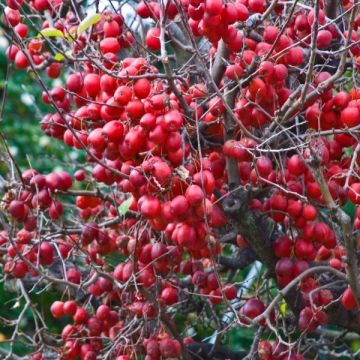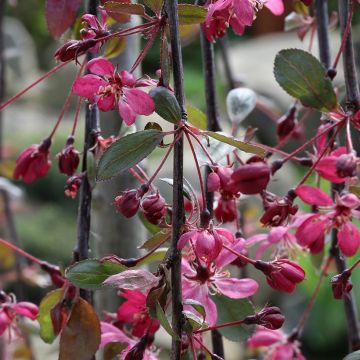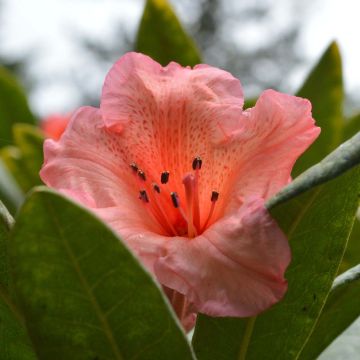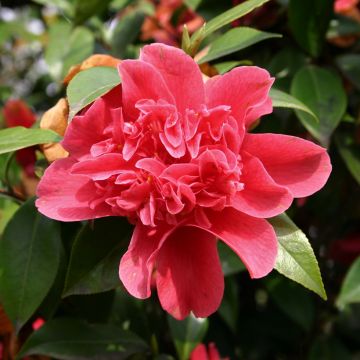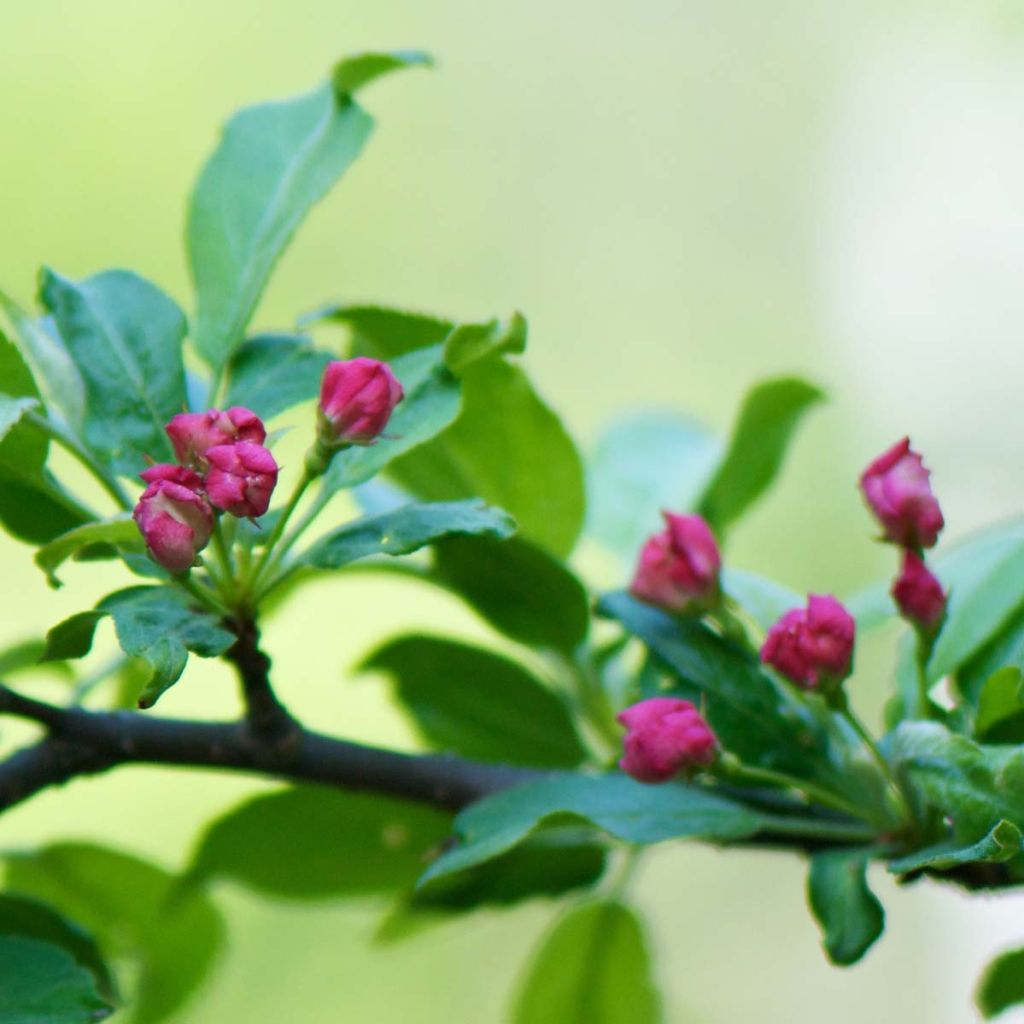

Malus toringo - Crab Apple


Malus toringo - Crab Apple
Malus toringo - Crab Apple
Malus toringo
Toringo Crab Apple
Although it has never flowered since it was planted (in 2019), it produced incredible flowers this year. The branches were entirely covered with them. A marvel. I hope it will bear fruits in autumn for the birds.
Anne, 27/05/2023
Why not try an alternative variety in stock?
View all →This plant carries a 24 months recovery warranty
More information
We guarantee the quality of our plants for a full growing cycle, and will replace at our expense any plant that fails to recover under normal climatic and planting conditions.
From €5.90 for pickup delivery and €6.90 for home delivery
Express home delivery from €8.90.
Does this plant fit my garden?
Set up your Plantfit profile →
Description
The ornamental apple tree Malus toringo, also known as Malus sieboldii, forms an oval to rounded crown, which gracefully expands with age. It is distinguished from other flowering apple trees by its leaves cut into narrow lobes, which colour beautifully in autumn. In spring, it is adorned with an abundant and fragrant flowering. It is pale-pink when it blooms, becoming pure white. The flowers are followed by very small orange crab apples with red highlights, which persist on the branches for a long time. This small tree is resistant to diseases and insects, and its moderate growth is perfect for small gardens.
Ornamental apple trees come from various genus species belonging to the Rosaceae family. Hardy, accommodating, and easy to grow, flowering apple trees are content with ordinary soil but prefer deep, loose, and moist soil, as well as sunny exposures. Once established, they withstand neglect while maintaining their generous nature. This resistant and graceful tree deserves to be planted more in our gardens.
Malus toringo is native to China, Korea, and Japan. A tall bush or small tree, it has a generally rounded to oval habit. Over time, the branches become slightly trailing, giving this apple tree a dense and flexible silhouette. It can grow as wide as it is tall. At maturity, it reaches an average height of 4.5m (15ft) with a spread of 3.5m (11ft). It maintains a balanced shape without the need for pruning, and develops flexible wood covered with a smooth grey-brown bark.
Flowering occurs in late April or early May, in the form of numerous buds of a slightly faded purple. They open into single flowers, 3.5 to 4cm (1 to 2in) in diameter. They are initially pale-pink before quickly turning white. These flowers, gathered in small clusters, open at the same time as the young leaves. The flowering is followed by the formation of numerous small crab apples that resemble cherries, measuring 1 to 1.2cm (1in) in diameter. At maturity in late summer, they are bright orange washed with red. These fruits, loved by birds, remain on the bush until December. The deciduous foliage is unusual for this species: it consists of leaves cut into 3 narrow, alternate, and toothed lobes, which are green with grey reflections until summer, turning yellow-orange before falling. Note that this variety, slightly susceptible to scab, is quite resistant to apple tree diseases.
Like many flowering apple trees, it is a good pollinator for early-flowering fruit trees. This small tree has more presence than a flowering cherry tree. Its abundant flowering may be less long-lasting than that of the latter, but this detail is compensated for by its fragrance, the beauty of its foliage from spring to autumn, the beauty of its fruits, and its elegant habit. It will find its place in a medium to small-sized garden, in an informal hedge, for example, accompanying large shrub or climbing roses trained as bushes, evergreen Viburnums, or lilacs. When space allows, ornamental apple trees, planted in a large hedge on a slope bordering a sunken path, create a rather magical scene not only in spring but also in autumn, thanks to their often sumptuous colours at the end of the season.
Report an error about the product description
Malus toringo - Crab Apple in pictures




Plant habit
Flowering
Foliage
Botanical data
Malus
toringo
Rosaceae
Toringo Crab Apple
Southeast Asia
Other Malus - Crabapple
Planting and care
Easy to grow in ordinary but deep soil, Malus toringo requires a bright exposure. Ornamental malus trees are generally very accommodating, but they like fertile, moist, and deep soils. After careful planting and installation accompanied by regular watering during the first two years, they manage on their own. Plant it in the sun or partial shade in fairly rich, moist but well-drained soil, allowing it room to spread. Dig a large planting hole. If the soil is poor, add compost to the planting soil, and apply fertiliser or compost to its base every spring.
Planting period
Intended location
Care
-
, onOrder confirmed
Reply from on Promesse de fleurs
Spring-flowering shrubs
Haven't found what you were looking for?
Hardiness is the lowest winter temperature a plant can endure without suffering serious damage or even dying. However, hardiness is affected by location (a sheltered area, such as a patio), protection (winter cover) and soil type (hardiness is improved by well-drained soil).

Photo Sharing Terms & Conditions
In order to encourage gardeners to interact and share their experiences, Promesse de fleurs offers various media enabling content to be uploaded onto its Site - in particular via the ‘Photo sharing’ module.
The User agrees to refrain from:
- Posting any content that is illegal, prejudicial, insulting, racist, inciteful to hatred, revisionist, contrary to public decency, that infringes on privacy or on the privacy rights of third parties, in particular the publicity rights of persons and goods, intellectual property rights, or the right to privacy.
- Submitting content on behalf of a third party;
- Impersonate the identity of a third party and/or publish any personal information about a third party;
In general, the User undertakes to refrain from any unethical behaviour.
All Content (in particular text, comments, files, images, photos, videos, creative works, etc.), which may be subject to property or intellectual property rights, image or other private rights, shall remain the property of the User, subject to the limited rights granted by the terms of the licence granted by Promesse de fleurs as stated below. Users are at liberty to publish or not to publish such Content on the Site, notably via the ‘Photo Sharing’ facility, and accept that this Content shall be made public and freely accessible, notably on the Internet.
Users further acknowledge, undertake to have ,and guarantee that they hold all necessary rights and permissions to publish such material on the Site, in particular with regard to the legislation in force pertaining to any privacy, property, intellectual property, image, or contractual rights, or rights of any other nature. By publishing such Content on the Site, Users acknowledge accepting full liability as publishers of the Content within the meaning of the law, and grant Promesse de fleurs, free of charge, an inclusive, worldwide licence for the said Content for the entire duration of its publication, including all reproduction, representation, up/downloading, displaying, performing, transmission, and storage rights.
Users also grant permission for their name to be linked to the Content and accept that this link may not always be made available.
By engaging in posting material, Users consent to their Content becoming automatically accessible on the Internet, in particular on other sites and/or blogs and/or web pages of the Promesse de fleurs site, including in particular social pages and the Promesse de fleurs catalogue.
Users may secure the removal of entrusted content free of charge by issuing a simple request via our contact form.
The flowering period indicated on our website applies to countries and regions located in USDA zone 8 (France, the United Kingdom, Ireland, the Netherlands, etc.)
It will vary according to where you live:
- In zones 9 to 10 (Italy, Spain, Greece, etc.), flowering will occur about 2 to 4 weeks earlier.
- In zones 6 to 7 (Germany, Poland, Slovenia, and lower mountainous regions), flowering will be delayed by 2 to 3 weeks.
- In zone 5 (Central Europe, Scandinavia), blooming will be delayed by 3 to 5 weeks.
In temperate climates, pruning of spring-flowering shrubs (forsythia, spireas, etc.) should be done just after flowering.
Pruning of summer-flowering shrubs (Indian Lilac, Perovskia, etc.) can be done in winter or spring.
In cold regions as well as with frost-sensitive plants, avoid pruning too early when severe frosts may still occur.
The planting period indicated on our website applies to countries and regions located in USDA zone 8 (France, United Kingdom, Ireland, Netherlands).
It will vary according to where you live:
- In Mediterranean zones (Marseille, Madrid, Milan, etc.), autumn and winter are the best planting periods.
- In continental zones (Strasbourg, Munich, Vienna, etc.), delay planting by 2 to 3 weeks in spring and bring it forward by 2 to 4 weeks in autumn.
- In mountainous regions (the Alps, Pyrenees, Carpathians, etc.), it is best to plant in late spring (May-June) or late summer (August-September).
The harvesting period indicated on our website applies to countries and regions in USDA zone 8 (France, England, Ireland, the Netherlands).
In colder areas (Scandinavia, Poland, Austria...) fruit and vegetable harvests are likely to be delayed by 3-4 weeks.
In warmer areas (Italy, Spain, Greece, etc.), harvesting will probably take place earlier, depending on weather conditions.
The sowing periods indicated on our website apply to countries and regions within USDA Zone 8 (France, UK, Ireland, Netherlands).
In colder areas (Scandinavia, Poland, Austria...), delay any outdoor sowing by 3-4 weeks, or sow under glass.
In warmer climes (Italy, Spain, Greece, etc.), bring outdoor sowing forward by a few weeks.



































